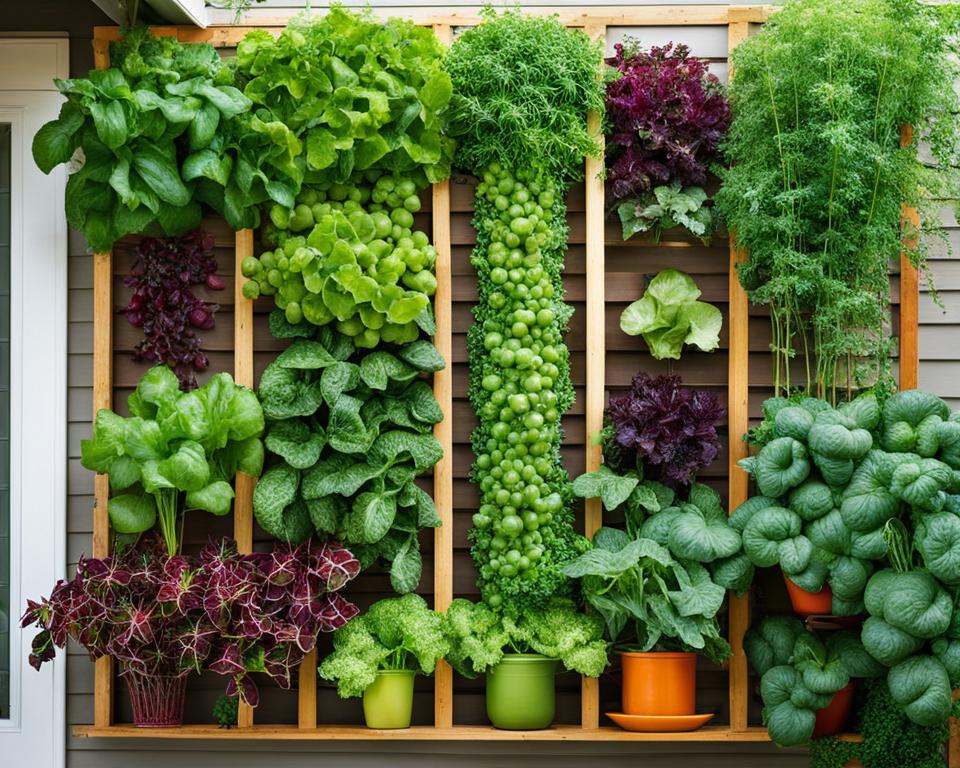Do you dream of growing your own fresh produce but feel constrained by limited space? Fret not, as vertical vegetable gardening is here to save the day and help you achieve your gardening goals. This innovative approach to urban gardening makes it possible to cultivate healthier and fresher vegetables right in your backyard, balcony, or even on your rooftop. Don’t let tight quarters hold you back from experiencing the joy and rewards of small space vegetable gardening. Dive into the world of vertical gardening and revolutionize the way you grow vegetables today!
Key Takeaways
- Vertical vegetable gardening maximizes limited space, making it suitable for urban dwellers.
- There are various benefits to growing vegetables vertically, like improved air circulation and sun exposure.
- Choose the right vegetables for your vertical garden based on plant size, growth habits, and suitability to the growing environment.
- DIY vertical gardening structures and pre-made kits are available to suit your needs and preferences.
- Combine vertical gardening with container gardening to maximize space and flexibility.
- Proper soil and nutrient management are crucial for healthy vertical vegetable gardens.
- Adapting to seasonal changes and extending the growing season is possible through smart vertical gardening techniques.
Understanding Vertical Vegetable Gardening
Vertical gardening is an innovative approach to growing plants by utilizing vertical space rather than horizontal land. By employing various structures and systems, gardeners can maximize their limited space and create lush greenery in their urban environments. In this section, we will explore the concept of vertical gardening, discuss its benefits, and help you determine if it is the right choice for your small space gardening needs.
What is Vertical Gardening?
Vertical gardening involves growing plants upward using support structures, like trellises, wall-mounted planters, or hanging containers. This technique is particularly useful in areas where horizontal space is limited, such as apartments, balconies, or small backyards. Vertical gardening ideas range from simple DIY projects to more elaborate structures and systems.
Vertical gardening techniques are not limited to just decorative plants — they can also be applied to growing vegetables. By employing these methods, you can cultivate your own fresh produce even in a small urban space. With a little creativity and planning, you can successfully transform your small area into a functional and beautiful vegetable garden.
The Benefits of Growing Vegetables Vertically
There are numerous advantages to vertical vegetable gardening, making it an attractive option for gardeners with limited space. Some of the key benefits include:
- Efficient use of limited space: Vertical gardens take up minimal ground space while allowing for a higher plant density, accommodating more plants within a small area.
- Improved air circulation and sun exposure: Growing plants vertically provides better access to sunlight and air circulation, potentially reducing the risk of diseases, pests, and uneven growth.
- Ease of maintenance: Plants grown vertically are more accessible, making tasks like watering, monitoring pests, and harvesting easier.
- Aesthetic appeal: Vertical greenery brings life and beauty to urban settings, enhancing the visual appeal of your space.
Is Vertical Gardening Right for You?
Before embarking on your vertical vegetable gardening journey, it is crucial to consider certain factors to determine if this approach aligns with your lifestyle and available resources. Consider the following aspects:
- Available space: Assess the size and layout of your area to determine how much vertical space you have to work with, and identify suitable locations for installing support structures or containers.
- Light conditions: Determine the amount of sunlight available in your space, as most vegetables require at least six hours of direct sunlight each day. Some plants can tolerate partial shade, but their productivity may be reduced.
- Commitment level: Vertical gardens may require regular maintenance to ensure the plants’ health. Be prepared to invest time and effort into watering, fertilizing, monitoring pests, and addressing any issues that may arise.
If these aspects align with your current situation and goals, vertical vegetable gardening may be an excellent choice for cultivating fresh produce in your small space.
Choosing the Right Vegetables for Vertical Gardens
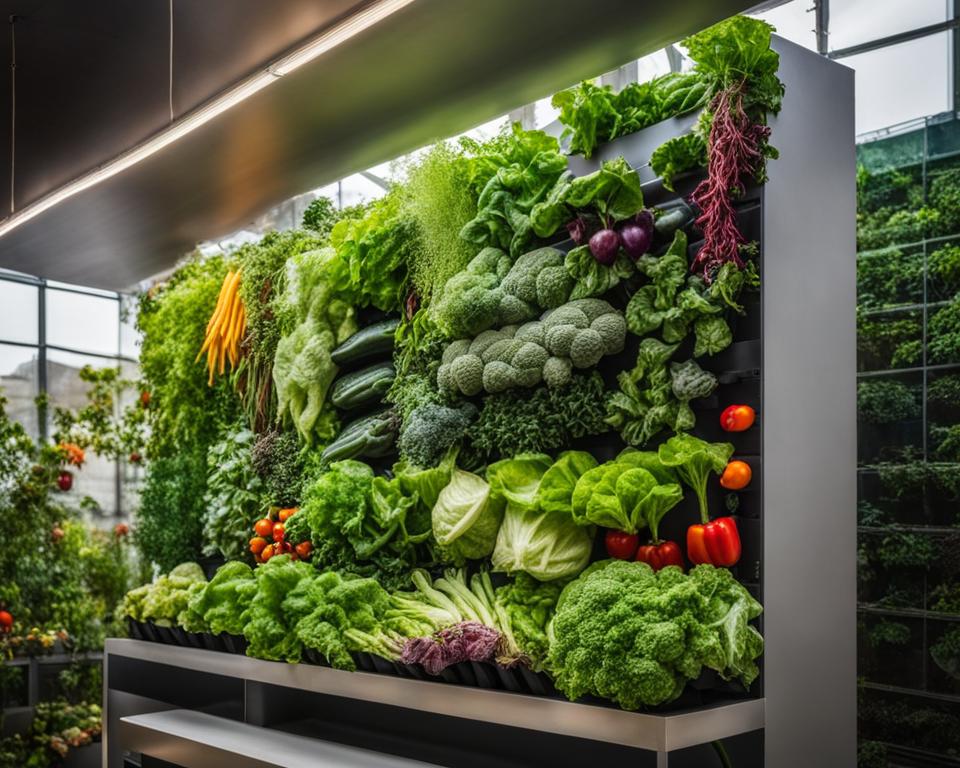
Selecting appropriate vegetables for your vertical garden is crucial in ensuring its success. A few essential aspects to keep in mind while choosing the right vegetables are plant size, growth habits, and suitability to vertical growing environments. In this section, we will guide you through these critical factors, helping you make the best selections for a thriving vertical garden.
Vertical gardening can transform small spaces into productive and visually appealing gardens, but it’s essential to choose the right vegetables that adapt well to this growing environment.
Here are some key vertical gardening tips for choosing the most suitable vegetable plants:
- Opt for plants with a natural climbing or trailing habit that readily grow vertically. Examples include pole beans, peas, tomatoes, cucumbers, and some squash varieties.
- Consider the size and weight of the harvested vegetable to ensure your vertical structure can support their growth. Smaller and lighter fruiting plants like cherry tomatoes or mini-cucumbers are ideal candidates.
- Choose vegetables that are adapted to your growing environment, taking into account factors like sunlight and temperature.
Now let’s dive deeper into the selection process by exploring some of the best vegetables in different categories for vertical gardens.
| Vegetable Group | Examples of Vertical-Friendly Varieties |
|---|---|
| Leafy greens | Swiss chard, kale, spinach, lettuce |
| Climbing vegetables | Pole beans, peas, indeterminate tomatoes, cucumbers, vining squash |
| Small fruiting plants | Cherry tomatoes, mini-cucumbers, strawberries, small pepper varieties |
| Herbs | Basil, cilantro, parsley, chives, thyme, oregano |
With this knowledge at hand, you are now equipped to make informed decisions when choosing vegetables for your vertical garden. By picking plants suited to your growing environment and considering factors like size, weight, and growth habits, you’re well on your way to creating a flourishing and productive vertical garden.
Vertical Gardening Systems and Structures
When planning your vertical vegetable garden, it’s essential to choose the right system and structure that best suits your needs and preferences. There are a variety of options available, including DIY vertical gardening structures and pre-made vertical gardening kits. This section will explore both options to help you make an informed decision.
DIY Vertical Gardening Structures
Creating your own DIY vertical gardening structures allows you to personalize and customize your garden setup. There are numerous materials and methods you can use to build a functional and unique vertical garden that perfectly fits your given space. Some popular options for DIY vertical gardening structures include:
- Trellises
- Vertical pallet gardens
- Ladder planters
- Wall planters
- Shoe organizers transformed into hanging planters
Pro-tip: When choosing materials for your DIY vertical garden, consider weather-resistant and durable materials such as PVC pipes, reclaimed wood, or metal.
“In DIY vertical gardening structures, consider weather-resistant and durable materials such as PVC pipes, reclaimed wood, or metal.”
One of the primary advantages of DIY vertical gardening structures is the ability to tailor the system to your specific needs, preferences, and available space. Additionally, building your own system can be a cost-effective solution if you’re working with a limited budget.
Pre-made Vertical Gardening Kits
For those who prefer a convenient, ready-to-assemble solution, numerous pre-made vertical gardening kits are available on the market. These kits come in a variety of styles, sizes, and materials to suit your specific needs. Some popular options include:
- Freestanding planters with built-in trellises
- Modular wall-mounted planters
- Tower gardens designed for self-watering
- Rectangular planter sets with vertical supports
| Types of Pre-made Vertical Gardening Kits | Advantages | Disadvantages |
|---|---|---|
| Freestanding planters with built-in trellises | Easy installation and mobility | May not accommodate a large number of plants |
| Modular wall-mounted planters | Space-saving and customizable | Requires proper installation to support weight |
| Tower gardens designed for self-watering | Low maintenance and efficient irrigation | May require a higher initial investment |
| Rectangular planter sets with vertical supports | Traditional look and easy plant access | May require additional support for heavier plants |
When selecting a pre-made vertical gardening kit, consider factors such as ease of installation, durability, and cost-effectiveness. Be sure to measure your available space before making a purchase, as well as research any additional tools or support structures that may be required for installation.
Ultimately, the choice between DIY vertical gardening structures and pre-made vertical gardening kits will depend on your personal preferences, budget, and the amount of time and effort you’re willing to invest in setting up your vertical garden. Regardless of your choice, creating a vertical vegetable garden is a rewarding and enjoyable activity that will provide you with fresh, homegrown produce in even the smallest of spaces.
Maximizing Space with Container Gardening
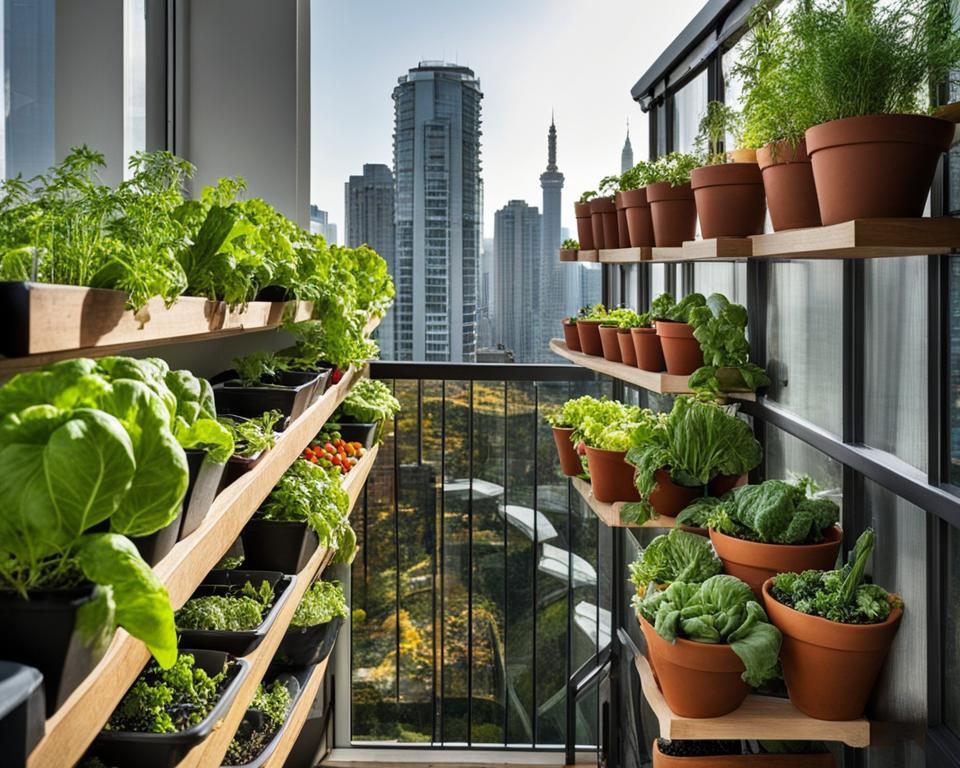
Container gardening is a versatile and space-saving option for urban dwellers and others with limited room for growing vegetables. By combining container gardening with vertical growing techniques, you can maximize your available space and yield a bountiful harvest even in the smallest areas. In this section, we will explore tips and tricks to make the most of container gardening in unison with vertical methods.
Choosing Containers and Vertical Solutions
The first step in successfully implementing container gardening is selecting the right containers and vertical solutions. Look for containers that allow for proper drainage, have sufficient depth for root development, and are made from durable materials. Remember that some vegetables have extensive root systems and will require deeper containers for optimal growth.
Consider implementing these popular vertical container gardening solutions:
- Trellises
- Green walls
- Pallet planters
- Hanging baskets
- Vertical pocket planters
Soil and Fertilizers for Container Grown Vegetables
It’s essential to use high-quality soil in your containers to provide sufficient nutrients and promote excellent drainage for your plants. Purchase a potting mix designed specifically for container gardening, or create your own blend by combining peat moss, vermiculite, perlite, and compost. Synthetic or organic slow-release fertilizer will also benefit your container-grown vegetables, but be sure to follow application recommendations for optimal results.
Watering and Sunlight Considerations
Maintaining moisture levels in your container garden can be a challenge, especially with vertical arrangements. Since soil in containers dries out faster than in traditional garden beds, you’ll need to be more attentive to your plants’ watering needs. Drip irrigation systems are an efficient watering solution that minimizes runoff and evaporation while ensuring that your plants receive consistent hydration.
Choosing the right location for your vertical container garden is crucial for providing your plants with adequate sunlight exposure. Be mindful of how the shadows cast by your vertical setup may impact the light conditions for other plants in your space. Adjust the positioning as needed to ensure all vegetables receive the appropriate amount of sunlight.
“A garden is a grand teacher. It teaches patience and careful watchfulness; it teaches industry and thrift; above all, it teaches entire trust.” – Gertrude Jekyll
By thoughtfully applying container gardening in tandem with vertical methods, you can make the most of your limited space and grow healthy vegetables. Combine these strategies to make every available inch count, and enjoy the satisfaction of harvesting fresh produce from your very own urban garden oasis.
Soil and Nutrient Management in Vertical Gardens
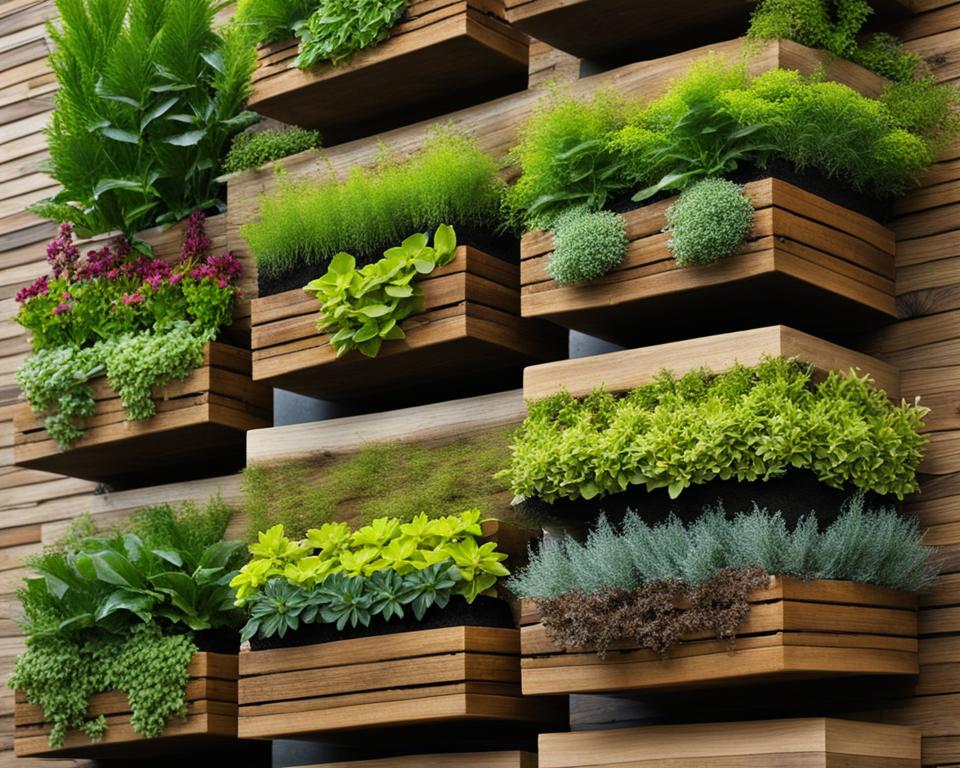
Choosing the right soil is crucial for the success of any garden, especially in vertical structures. In this section, we will discuss the best soil mixtures for vertical vegetable gardens and provide guidance on selecting appropriate fertilizers and techniques for effectively nourishing plants in a vertical setting.
Best Soil Mixtures for Vertical Vegetable Gardening
Selecting the right soil mixture for your vertical garden ensures proper drainage and nutrient retention for thriving vegetable plants. A good soil mix is generally composed of three main elements:
- Organic matter
- Drainage material
- Aeration material
Here is a table showcasing popular components for each element:
| Element | Popular Components |
|---|---|
| Organic Matter | Compost, peat moss, coconut coir |
| Drainage Material | Perlite, vermiculite, pumice |
| Aeration Material | Coarse sand, bark chips, crushed lava rock |
A well-balanced soil mix for vertical vegetable gardens typically includes equal parts of organic matter, drainage material, and aeration material. This mix provides essential nutrients, allows excess water to drain, and maintains proper airflow around plant roots.
How to Fertilize Your Vertical Garden
Fertilization is key to promoting healthy growth and maximizing yields in vertical gardens. Consider these vertical gardening tips for effectively nourishing your plants:
- Choose the right fertilizer: Select a balanced, slow-release fertilizer that provides essential nutrients like nitrogen, phosphorus, and potassium. Opt for organic fertilizers like compost, worm castings, or fish emulsion for a more environmentally friendly approach.
- Monitor nutrient levels: Regularly check the nutrient levels of your soil and replenish them as needed. Over time, nutrients in the soil can be depleted and need to be replenished.
- Follow the recommended application rates: Always follow the manufacturer’s instructions when applying fertilizer to avoid over-fertilization, which can harm your plants.
- Consider liquid fertilizers: In certain configurations, such as hanging pockets or vertical containers with limited soil volume, liquid fertilizers can be a practical solution for consistent nutrient delivery.
By carefully selecting the right soil mixture and providing proper fertilization, your vertical vegetable garden will thrive, yielding bountiful, healthy produce to enjoy.
Irrigation Solutions for Small Space Gardening
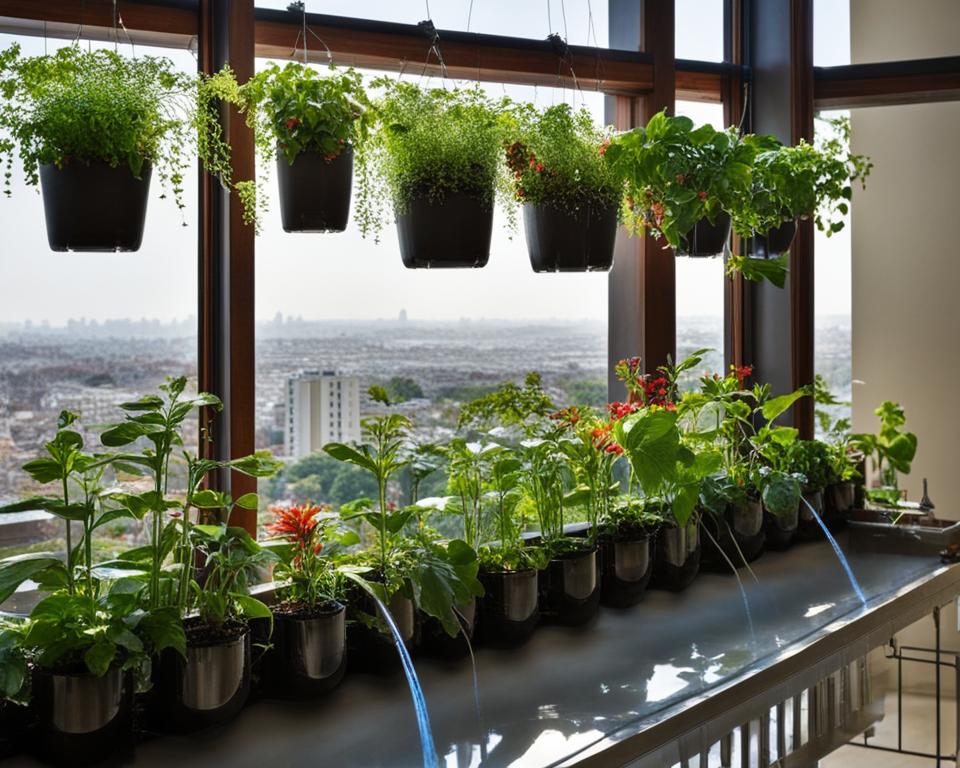
Irrigation plays a crucial role in the success of any garden, including vertical gardens. Efficient water usage and proper hydration are essential to keep your plants healthy and thriving. In this section, we’ll cover various irrigation solutions for vertical gardens and how to tailor them to meet the unique needs of small space gardening.
When choosing an irrigation solution for your vertical garden, consider factors such as the type of vertical gardening system, plant variety, and your budget. Here are some popular irrigation methods for vertical gardens:
- Self-Watering Containers and Planters
- Drip Irrigation Systems
- Soaker Hoses
- Bottle Irrigation
- Manual Watering
To give you a better understanding of each method, we will delve into each option and discuss its benefits and drawbacks:
Tip: Regardless of the irrigation method you choose, always monitor your plants and adjust your watering schedule to maintain proper moisture levels and prevent waterlogging.
Self-Watering Containers and Planters
These containers have a built-in reservoir that stores water, slowly releasing it to the plants through a wicking system. This set-and-forget method ensures a consistent water supply, making it perfect for busy urban gardeners. However, self-watering containers can be more expensive and may not accommodate large vertical gardens.
Drip Irrigation Systems
For larger vertical gardening installations, a drip irrigation system offers precise control of water distribution. Consisting of a network of pipes with emitters placed at each plant, this method delivers water directly to the root zone. It minimizes water waste but requires an initial investment for materials and installation.
Soaker Hoses
Soaker hoses are porous or perforated hoses that release water along their length. Laying a soaker hose along your vertical garden ensures even water distribution, although it works best for narrow, wall-mounted systems. Soaker hoses are inexpensive but may require frequent attention to avoid under- or over-watering.
Bottle Irrigation
For budget-conscious gardeners, bottle irrigation is a simple DIY solution that utilizes upcycled plastic bottles. By creating small holes in the bottle and filling it with water, you can supply a slow drip of water to plants. This method is cheap and eco-friendly, although it may be less suited for large-scale vertical gardens.
Manual Watering
Manual watering with a watering can or hose is the most straightforward method for small vertical gardens. Although it requires regular attention and effort, it allows you to carefully control water application. However, this method can be time-consuming and may result in uneven watering.
| Method | Pros | Cons |
|---|---|---|
| Self-Watering Containers | Consistent water supply, low maintenance | Higher cost, may not suit large gardens |
| Drip Irrigation | Precise control, water-efficient | Initial investment for materials and installation |
| Soaker Hoses | Even water distribution, inexpensive | Requires monitoring, better for narrow systems |
| Bottle Irrigation | Budget-friendly, eco-conscious | Not ideal for large-scale gardens |
| Manual Watering | Controlled water application, accessible | Time-consuming, potential uneven watering |
Remember, the key to successful irrigation in vertical gardens is finding the right balance between water savings and adequate moisture levels for your plants. By exploring these various irrigation methods, you’ll ensure your vertical garden remains healthy and productive.
Protecting Your Vertical Garden from Pests and Diseases
Protecting your vertical garden from pests and diseases is crucial for maintaining healthy and thriving plants. With the right knowledge and organic solutions, you can help your garden withstand attacks from common pests and diseases. Ensuring your garden is well-managed and free of pests and diseases will contribute to overall garden success.
Identifying Common Pests in Vertical Gardens
First, let’s look at the most common pests you might encounter in vertical gardens:
- Aphids
- Spider mites
- Whiteflies
- Slugs and snails
- Caterpillars
Aphids, spider mites, and whiteflies are small insects that can be found on the leaves and stems of your plants. They suck sap from plants, causing curling and yellowing leaves. A telltale sign of their presence is the sticky honeydew they excrete on leaves, which can lead to sooty mold growth. Slugs and snails feed on leaves and can be particularly damaging to young plants and seedlings, leaving irregular holes and slime trails behind. Caterpillars mostly feed on foliage, although some will attack stems and fruits as well.
Early detection and prevention are key to minimizing pest problems in your garden. Make it a habit to inspect your plants often and deal with pests as soon as you spot them.
Organic Solutions for Disease Control
Organic disease control is essential for sustainable gardening practices. Here are some organic treatments and prevention methods to protect your vertical garden from diseases:
- Neem oil: Neem oil is a natural pesticide with broad-spectrum effectiveness. It can help control various common pests and diseases, making it a valuable tool for your vertical garden.
- Cultural practices: Good cultural practices, such as adequate plant spacing, pruning, and proper watering, can help minimize disease development in your garden.
- Companion planting: Planting disease-resistant companion plants near susceptible plants can help deter pests and pathogens and reduce the overall risk of diseases.
- Homemade remedies: Solutions made from garlic, onion, pepper, or essential oils can be effective against certain pests and diseases. Be cautious in using these remedies as they can sometimes harm beneficial organisms as well.
Remember that not all pests are harmful and actually some insects can be beneficial to your vertical garden. For instance, ladybugs and spiders are natural predators of aphids, helping to keep their population in check. Encourage beneficial insects by providing them with shelter, food sources, and water. Ultimately, a well-balanced ecosystem will help contribute to the success of your vertical garden.
Vertical Gardening Tips for Healthy Produce
To ensure that your vertical garden thrives and yields healthy produce, follow these essential vertical gardening tips. These guidelines will help you promote plant growth, boost productivity and maintain the overall health of your garden.
- Choose suitable plants: Opt for vegetable varieties that are naturally inclined to grow vertically, such as climbing peas, pole beans, and vine tomatoes.
- Support your plants: Provide trellises, cages, or netting to give your plants adequate support and encourage upward growth.
- Maximize sun exposure: Position your vertical garden in an area where it receives optimum sunlight to promote photosynthesis and growth.
- Prune regularly: Trim excess foliage and remove dead or diseased leaves to allow better airflow and light penetration, resulting in healthier, bushier plants.
- Proper spacing: Space your plants according to their individual requirements to reduce competition for resources, improve airflow, and minimize the risk of pests and diseases.
- Maintain soil quality: Use nutrient-rich soil mixtures that provide adequate drainage and support root growth, and fertilize your plants regularly.
- Monitor for pests and diseases: Check your plants frequently to identify and address any pest or disease issues before they escalate.
Selecting suitable plant supports and utilizing proper spacing techniques is vital in growing healthy produce in your vertical garden. Below is a table summarizing these key elements:
| Plant | Support Type | Ideal Spacing |
|---|---|---|
| Tomatoes | Cages or stakes | 24-36 inches |
| Pole beans | Trellises or netting | 4-6 inches |
| Peas | Trellises or netting | 3-4 inches |
| Cucumbers | Trellises or netting | 12-18 inches |
| Squash and melons | Sturdy trellises | 24-36 inches |
In conclusion, following these vertical gardening tips will optimize your garden’s productivity, resulting in a bountiful harvest of healthy produce. Paying close attention to plant selection, support structures, adequate sunlight, and proper garden management practices will contribute to the overall success and longevity of your vertical garden.
Maintaining Your Vertical Garden Through the Seasons
As the seasons change, so do the needs of your vertical garden. In this section, we will explore strategies for adapting your vertical garden to different weather conditions and maintaining productivity all year round. Additionally, we will delve into techniques to extend your growing season, making the most of your small space and vertical gardening systems.
Adapting to Seasonal Changes
Adapting your vertical garden to seasonal changes is crucial for maintaining a healthy and productive space. Some essential adaptation strategies include:
- Regularly monitoring and adjusting nutrient and water levels in your vertical gardening systems as the seasons change. Keep in mind that plants may require more water in hotter months and fewer nutrients during the dormancy period.
- Rotating and rearranging plants to take advantage of seasonal light conditions, maximizing sun exposure during cooler seasons and providing shade during intense summer heat.
- Adding or removing insulation and windbreaks around your vertical garden to protect plants from temperature fluctuations and strong winds.
- Adjusting plant selection to include seasonal crops, such as starting cool-weather vegetables in the spring and harvesting heat-tolerant varieties in the summer.
Extending Your Growing Season Vertically
Vertical gardens offer unique opportunities to extend the growing season. Some techniques to help you achieve this goal include:
- Creating microclimates: Use vertical structures to insulate the growing area and protect plants from harsh weather conditions like early frosts or heatwaves. For example, placing plants against a south-facing wall can help absorb and retain heat, creating a warmer microclimate for longer growing seasons.
- Using vertical plantings with diverse crop mixtures: Incorporate a mix of cold-hardy and heat-tolerant plant varieties to take advantage of their different growing seasons, ensuring a continuous harvest.
- Implementing protective covers: Transparent covers like row covers or cold frames can be used to shield plants from cold temperatures and extend the growing season. Covers can also be removed during the day to allow for proper ventilation and light penetration.
- Optimizing vertical garden structures: Enhance your vertical garden with features like built-in irrigation systems, self-watering containers, or trellises to encourage upward growth and increased yield. These design elements focus on efficient water and nutrient delivery as well as enhanced sun exposure, helping extend the growing season.
By adapting your vertical garden to the changing seasons and implementing strategies to extend the growing season, you can make the most of your small space and continue enjoying fresh, homegrown produce throughout the year.
Embracing Vertical Vegetable Gardening for Small Space Success
As a solution to growing vegetables in limited spaces, vertical vegetable gardening offers immense benefits and possibilities for urban dwellers and small-space gardeners. Vertical gardens make efficient use of space, resulting in healthier plants and better yields. By implementing space-saving and smart gardening techniques, you can create a personalized and flourishing vertical garden right in your own small space.
No matter the size of your gardening area, selecting the right vegetable varieties, structures, and soil mixtures are crucial to vertical gardening success. With a combination of DIY structures and pre-made kits, you have the flexibility to design a unique vertical garden that suits your specific needs and style preferences. Properly managing irrigation, pest control, and seasonal changes helps to maintain a thriving vertical garden throughout the year.
Embracing vertical vegetable gardening not only contributes to sustainability and self-sufficiency, but also adds beauty and value to your living space. Take the leap towards small space gardening success and experience the joy of growing your own fresh produce vertically. Let your creativity and resourcefulness guide you in establishing a productive and stunning vertical garden, tailored to your unique environment and needs.
FAQ
What are some ideal vegetables for vertical gardening?
Some ideal vegetables for vertical gardening include climbing peas, beans, cucumbers, squash, tomatoes, and many varieties of leafy greens.
Can I grow root vegetables in a vertical garden?
While some root vegetables may not be well-suited for vertical gardens, others like radishes, carrots, or beets can be grown vertically if you provide deep containers with ample soil depth to accommodate root growth.
What materials can I use to build my own vertical gardening structure?
Materials like wood pallets, trellises, wall planters, and hanging baskets can all be repurposed or built to create a DIY vertical gardening structure.
How do I choose the right container for my vertical vegetable garden?
When choosing containers for your vertical garden, consider factors such as the size and growth habit of the plant, drainage, and the material of the container itself. Opt for durable materials that can support the weight of soil and plants, and ensure that your container provides adequate drainage to prevent root rot.
How do I manage water and nutrient needs in a vertical garden?
Selecting the right soil mixture with good drainage and nutrient retention is crucial. Fertilize your plants regularly using appropriate fertilizers and techniques suited for vertical settings. When it comes to irrigation, consider drip irrigation systems or self-watering containers as they provide efficient water usage and ensure proper hydration for your plants.
How do I protect my vertical garden from pests and diseases?
Monitor your vertical garden for common pests and signs of their presence. Implement organic solutions to control pests and diseases, such as introducing beneficial insects, using natural pesticides, or applying safe fungicides when necessary.
How can I maintain my vertical garden through different seasons?
Adapt your vertical garden to seasonal changes by selecting plant varieties suited for each season, providing protection from harsh weather conditions, and implementing techniques to extend the growing season, such as creating microclimates or using cold frames and row covers.

